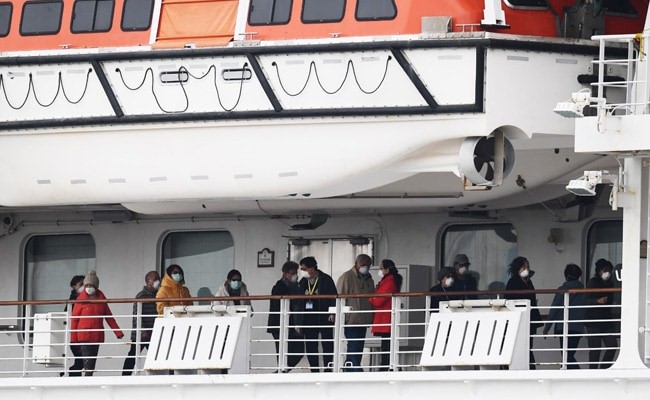
Passengers leave quarantined virus-hit Japan cruise ship
Relieved passengers began leaving a coronavirus-wracked cruise ship in Japan on Wednesday after testing negative for the disease that has now claimed more than 2,000 lives in China.

Relieved passengers began leaving a coronavirus-wracked cruise ship in Japan on Wednesday (February 19) after testing negative for the disease that has now claimed more than 2,000 lives in China.
The Diamond Princess has proved a fertile breeding ground for the virus with at least 542 positive cases, and there is mounting criticism of Japan’s handling of quarantine arrangements as passengers get ready to go out and mingle among people again, increasing the chance of infection by the virus.
The ship is the biggest cluster outside China, where new figures showed the death toll surging beyond 2,000 with more than 74,000 infected. Hundred more cases have been reported in two dozen countries.
For around 500 passengers who were allowed to disembark after testing negative, a difficult 14-day quarantine period has come to an end after their dream cruise turned into a nightmare of fear and crushing boredom confined in many cases to small windowless cabins.
“NEGATIVE! Me, son, husband, mom, and dad! Thank you Lord for protecting us… So emotional now,” tweeted passenger Yardley Wong, who has been cooped up with her six-year-old son.
#day14 #coronavirus #COVID19 NEGATIVE! Me, son, husband, mom and dad! Thank you Lord for protecting us! ?????? we are leaving tomorrow ! So emotional now! #hangintherediamondprinces pic.twitter.com/P6JqtlnwgE
— Yardley Wong (@yardley_wong) February 18, 2020
Those with no symptoms and a negative test received an official certificate saying they posed “no risk of infection of nCoV, as the said person has also presented no symptoms including fever at the time of infection.” But not everyone was so lucky.
British passenger David Abel, who became a minor celebrity with his upbeat video messages in the early days of the quarantine — including a cheeky request to the captain for whisky — typified the mood shift aboard.
“It’s all getting to us now and it’s not just me, it’s the other passengers as well. It’s the not-knowing factor that is the real challenge. Mentally, it’s now taking its toll. Right now, it’s very hard to remain focused on anything,” he said.
He later announced he and his wife Sally had tested positive.
Meanwhile, in Japan, some have raised concerns about allowing people from the cruise ship to board flights home or spread out into the notoriously-crowded Japanese capital.
Related news | Virus cases on Japan ship rise to 454, four Indians responding to treatment
Kentaro Iwata, a professor at the infectious diseases division of Kobe University, blasted the on-ship quarantine as a “major failure, a mistake”. “It is highly likely secondary infections occurred,” Iwata said, saying skepticism from abroad of the quarantine was “only natural”.
He later said in a video published online that he was self-quarantining after a brief visit to the ship where he raised major concerns about the procedures on board. “It was completely chaotic,” he said.
Several countries appear to have lost patience with the on-board quarantine and have prepared chartered planes to bring back their citizens. In the first such evacuation Monday, more than 300 Americans flew home even though 14 of the passengers had tested positive. Early on Wednesday, South Korea flew six of its nationals plus a Japanese spouse to Seoul. They will be placed in isolation for 14 days, the Yonhap news agency reported.
Britain, Hong Kong, and Australia are among other countries that have vowed to repatriate people from the ship but will insist on a further 14-day quarantine on home soil.
Related news | Please rescue us, appeal Indian crew onboard virus-hit ship off Japan
Nathalie MacDermott, a medical expert at King’s College London, stressed the importance of continued quarantine even after leaving the ship. “Given the circumstances on board the Diamond Princess, those passengers leaving the boat should be managed in a similar manner to those individuals departing a highly affected city or region,” said MacDermott.
She recommended, “Further 14-day self-isolation or quarantine period would be advisable even in the absence of symptoms.” Disembarkation is expected to take around three days as more test results become available.
Anyone who has had contact with an infected passenger will have to undergo 14 more days in quarantine. In addition, the crew will begin a new quarantine when the last passenger has disembarked.
However, people in Yokohama appeared supportive of the decision to allow the passengers out despite virus fears. “I am sure those people on board must be really worried. I hope they can go back to their normal life soon,” said 51-year-old Isamu Habiro.
“As a Yokohama resident, I don’t want them to be treated unfairly. I want to cheer for them,” Habiro said.


